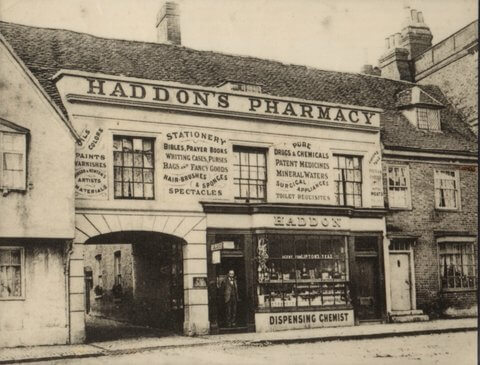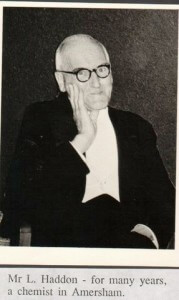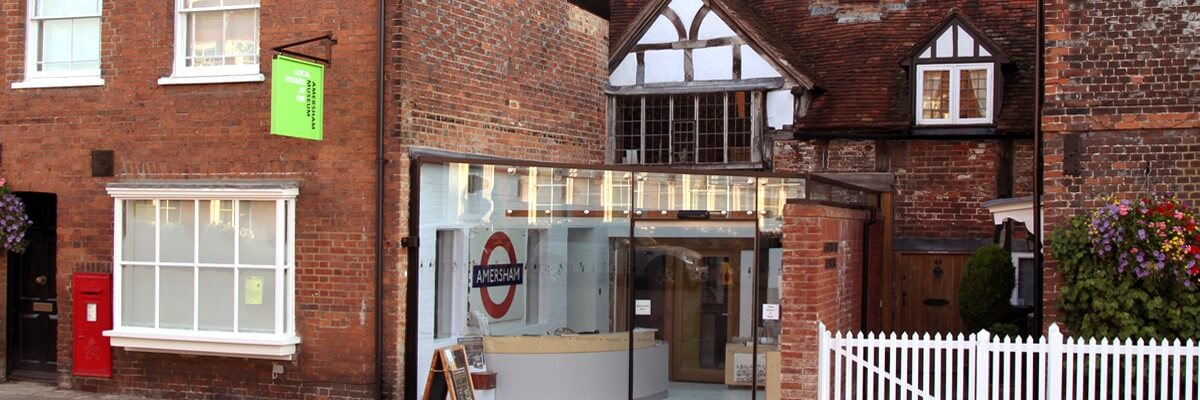The following is a compilation, made by R. M. Bennett in February 1999, from a number of typescripts produced by Laurence (Laurie) Haddon and is reproduced with permission. The author’s wife is the niece of Laurie Haddon.
The History of the Old Pharmacy in the High Street 1837 to 1966 (now 38 High Street)

In the year 1834 there was an old apothecary and herbalist by the name of Pike living in the town of Amersham and in 1837 he took over the lease of the premises situated on the south side of the high street west of the footpath to the British School, Baptist Chapel and Burial ground. Here he established his chemist business.
In 1840 this was taken over by Thomas Hailey Morton who was one of the deacons of the Baptist Chapel and had connections residing in Chesham Bois. He was reputed to be a fine looking man with a handsome curly brown beard. He added extensive living accommodation to the rear of the original building and there is one brick still in the wall above one of the rooms at the rear bearing the initials “T.H.M.” and the date “1840”, to commemorate the building work.
Some years later, between 1850 and 1860, another chemist, named Nathan Smith, took over from Hailey Morton and he built the warehouse. He did an extensive agricultural business and manufactured many veterinary products with a wide sale as well as fertilisers. He had a large rectangular deep wooden vessel, kept in the yard by the wall of the store, which was hired out to local farmers for dipping sheep when chemicals for this purpose were sold. He also manufactured mineral waters and his famous “Dandelion Coffee”, which was produced and packed and had a wide local sale. The warehouse had three floors each with big double doors which swung outwards for the handling of supplies. On the ground floor were several forty gallon steel vats or drums, all with taps attached, for storage of oils such as linseed, whale, rape, cotton seed, boiled oil, etc. with smaller ones for petroleum oils, paraffin, industrial and methylated spirits and stone jars of distilled water. There were also large containers of white lead and red lead together with one hundred weight barrels of sulphur and bins for storage of magnesium sulphate, sodium sulphate, sodium bicarbonate and all the dry chemicals and salts used in the old time chemist’s business. The second floor was divided into three carts and in one small room, lit by gas, was a fully fitted experimental chemical laboratory. Another part housed a large hand-operated drug and chemical grinding mill. The operating wheel was some five feet in diameter. On the third and top floor was a two-ton hand operated crane, which had a much heavier and larger driving wheel geared to a steel drum around which the chain was wound. It had a brake to control the working and a lever to disengage the gear, The chain went out through a pulley-box in the outer wall to another pulley on the derrick which was swung out at right angles to the wall when in operation. The crane was used for hauling up the one and two hundredweight kegs and drums of chemicals which were required for the various processes of manufacture. Laurence can recall in his school days sitting astride the double grappling-hook on the chain and being hauled up and down on the chain.
Documents show that the property was owned by Edward Adams Cousins, described as “Gentleman”, of Nash Court, Tenbury, Worcestershire and in 1889 he granted a further lease to the brothers Alfred John Hea!d of Burnham and Alfred Francis Heald of Amersham, both Chemists and Druggists.
In 1885 Nathan Smith had been succeeded by Alfred Francis Heald but he was more interested in medicine and made a comparatively short stay so that in 1892 he disposed of the business and it was taken over by Albert Henry Haddon, a young pharmacist who had qualified in 1881 and left his home in Great Easton in Leicestershire for a pharmacy in Ryde, Isle of Wight. Mr. Heald then left for medical school and eventually qualified in medicine and took over a practice in the east end of London where he gave a dedicated service to London’s poor. He was still there when Mr. David Lloyd-George introduced his first national health service in 1910.
Albert Haddon came to Amersham in the October of 1892, the first week that saw the official opening of the extension of the Metropolitan Line railway to Aylesbury and beyond. Later, in about 1895 when the Great Central built their line from Cranfield Gardens to Marylebone and linked with the Metropolitan to have running powers over the Metropolitan Line to Aylesbury it became the Metropolitan and Great Central Railway Joint Committee.
When Mr. Haddon took over the lease of the property it had 17 years to run. This, and two other shop properties in the High Street, one occupied by Mr. G. Brazil the butcher, next to the Elephant and Cast!e, and the other next door, the grocer’s shop of Mr. A. P. Bizzell, were all owned by Edward Adams Cousins who, having moved to Bournemouth, decided to dispose of his properties in Amersharn. In 1894/5 the properties were offered for sale by auction, the sale to take place at the Griffin Hotel which was then the leading inn of the town.
In Whielden Street, there was, at this time, a well known local draper and outfitter named Henry Fuller carrying on his business in the property, Whielden House, which had once been the old Poor Law Institution or Workhouse, before the present building built in 1888, which eventually became part of the present Amersham Hospital, was erected. When the sale was advertised, he contacted Albert Haddon and asked if he intended bidding at the sale. When told that Mr. Haddon would not he making any attempt to obtain the property, he then asked him if he would attend the auction and obtain the property for him. In return he promised a further twenty one years’ lease to Mr. Haddon, after his present lease expired, and to put in a new shop front at the same time. Accordingly Albert Haddon obtained the property at the sale for the sum of £640. In 1909 the new lease was granted and in 1910 the new front installed. It is still there today when this history is written. When A. H. Haddon came to Amersham in 1892 he obtained his supplies from an old firm of chemists’ suppliers and shop fitters named Sangers then operating from Euston Road, London NW. Goods were sent by passenger train as the quickest form of delivery. Goods could be placed on the train at Marylebone Station and the train met at Amersham and collected forty minutes later, if urgently needed. In recent years Messrs. Sangcrs have moved to new modern headquarters at Croxley Green where they have closed the shopfitting department and specialise in supplying the National Health Service and to this day deliver by road in their own vans twice daily. They installed the new front and this is still to be seen, exactly as then fitted, at the premises at 38 High Street today. The lower half was restored by another old chemist’s shopfitting firm in 1963, exactly as originally fitted, but alas it is no longer a Pharmacist. It is here interesting to state, that in 1966 when Haddons left, the account with Messrs. Sangers Ltd was still in operation and supplies were still being obtained from them after seventy four years and was the firm’s oldest account.
Under the name of Haddon the business expanded. A friendly personal business was established in which service to the customer and the town, with support of all local enterprises and institutions, was the main objective. With the development of the area due to the coming of the railway, business was expanded and the lines stocked increased. A full off-licence for wines and spirits was obtained, stationery and fancy goods were stocked, local post cards from Haddon’s own negatives were produced and Gosses local arms china agency obtained. Optics were added and a London dentist came once weekly for extraction of teeth.
When Albert Haddon passed away in April 1936 after just one week’s illness following a coronary attack, he left everything to his wife, Agnes Gertrude Haddon. By the time his last lease on the property had ended in 1930, Henry Fuller had died and it had passed to his two daughters Miss Dora and Miss Grace Fuller. They had wished to sell and Mr. Haddon had purchased. The business was then run on the widow’s behalf by the executors. With the outbreak of war in 1939 it was decided, to safeguard her position, to turn the business into a private limited company with her as chairman and this was done in 1940 and it became “Haddons Chemists Ltd” Chemists, Opticians, Stationers and Wine and Spirit Merchants She lived to the ripe old age of 89, passing on just before her 90th birthday, and when she died in 1952 the property went to her daughter and her shares in the company, and the rest of her estate, to her son Laurence who was also the secretary of the company.
 In October 1966 when Laurence, the last of the family, decided to retire, as the prospective and eventual purchaser was contemplating changes it was decided, for sentimental reasons, not to sell the name and in consequence only the property, stock, and fixtures were offered for sale. No goodwill was asked for, and when the sale and transfer were complete, the company was formally wound up. It is truthfully said that from 1837 until 1966, when the last Haddon left, the service in the pharmacy given to Amersham over the one hundred and twenty nine years had covered the period from leeches to penicillin.
In October 1966 when Laurence, the last of the family, decided to retire, as the prospective and eventual purchaser was contemplating changes it was decided, for sentimental reasons, not to sell the name and in consequence only the property, stock, and fixtures were offered for sale. No goodwill was asked for, and when the sale and transfer were complete, the company was formally wound up. It is truthfully said that from 1837 until 1966, when the last Haddon left, the service in the pharmacy given to Amersham over the one hundred and twenty nine years had covered the period from leeches to penicillin.
Left at the Pharmacy for the new owners, were complete records of every private prescription which had been dispensed from the first day of establishment in October 1837 until the last day of October 1966, They were contained in eleven volumes each distinguished by a letter running from “A” to “K”, which was the book in use at the time, and each entry numbered in sequence and the names indexed in alphabetical order. The early books were bound in calf and the entries made in beautiful copperplate handwriting, like legal documents, obviously written with quill pens. The black ink remained in excellent condition and the pages in good state of preservation.
A perusal of the indexes revealed many names of old past residents such as Aldridge, Barry, Beaver, Berry, Bizzell, Boyd, Brazil, Colley, Crook, Crowhurst, Tyrwhitt Drake, Fountain, Gardner, Gomm, Grace, Grist, Gurney, Haynes, Keen, Kitchener, Macdonald, Martin, Merridan, Morton, Orton, Podbury, Ports, Raine, Ramage, Redrup, Rushworth, Shrimpton, Southam, Turner, Weller, Winfield, to mention some.
Two interesting examples from Book B covering a period in the late 1840’s:-
1. The doctor’s instructions for preparing a Blister, followed by directions for use to be copied on to the label, “The Blister behind the ear and six leeches above the eye.”
2. The doctor’s instructions for dispensing an ointment followed by the directions, “Anoint the skin with a dean linen rag and apply the ointment to the affected part.”
There were plasters to be made and spread on leather or brown paper, pills to he made and either varnished or coated with silver or gold leaf. No doubt the coating depended on the status of the patient.
Laurence stated that had he known what was to happen to the Pharmacy these books would never have been handed over, except those referring to recent years, which would be needed for repeat prescriptions. The old records would have been retained and would have been presented to the Amersham Museum.
Lastly, in the Pharmacy, there was a drawer with the usual gold label which said “Issue Pea”. This contained some purely wooden pills, about the size of the kernel of a hazelnut These were given when a “stoppage of the bowels” was suspected and was probably appendicitis. Accompanied by a strong aperient, if the pill was passed, or in other words “issued”, it was assumed that the patient would recover. This drawer with its label should still be seen at No. 38 High Street. Enter the shop and look to the right on the top row about six along from the big window.

